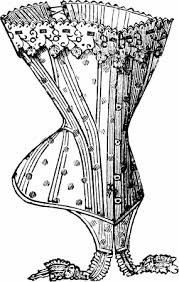1900-1909: First Changes in American clothing
Origin:
In the Edwardian Era (1901-1910) which was also known as "The Last Age of Elegance" King Edward VII enjoyed beauty and elegance, so during his reign the fashion changed from the large skirts, and large sleeves of the Victorian era (from: 1837-1901) to the small waisted, silhouette, and "curvy" dress of the Edwardian era.
Primary Source: "The woman of 1901 presented a new, flowing silhouette unlike that of any of her Victorian predecessors. Her skirt curved outwards over her full behind, downwards and apparently slightly inwards towards knee-level and then sharply outwards again at the hem. This gave the appearance of a concave skirt. It often extended into a sweeping train, even during the day. Carried out in soft, flowing fabrics and with little drapery to interrupt the outline, it could reveal more of the figure than the slim but stiff and heavily draped skirts of the late 1870's for example. The bodice above was usually moulded on a tight, and well-boned foundation. The outer layer was cut a little fuller and longer in front than the lining and was arranged to droop over the waistband. The sleeves of 1901 were quite tight at the top but flared out from below the elbow, drooping over the tight cuff. The whole effect was curved, flowing and extremely feminine."
In the Edwardian Era (1901-1910) which was also known as "The Last Age of Elegance" King Edward VII enjoyed beauty and elegance, so during his reign the fashion changed from the large skirts, and large sleeves of the Victorian era (from: 1837-1901) to the small waisted, silhouette, and "curvy" dress of the Edwardian era.
Primary Source: "The woman of 1901 presented a new, flowing silhouette unlike that of any of her Victorian predecessors. Her skirt curved outwards over her full behind, downwards and apparently slightly inwards towards knee-level and then sharply outwards again at the hem. This gave the appearance of a concave skirt. It often extended into a sweeping train, even during the day. Carried out in soft, flowing fabrics and with little drapery to interrupt the outline, it could reveal more of the figure than the slim but stiff and heavily draped skirts of the late 1870's for example. The bodice above was usually moulded on a tight, and well-boned foundation. The outer layer was cut a little fuller and longer in front than the lining and was arranged to droop over the waistband. The sleeves of 1901 were quite tight at the top but flared out from below the elbow, drooping over the tight cuff. The whole effect was curved, flowing and extremely feminine."
Purpose:
The dress style was changed mainly because of the change in the corset style, this was mainly due from the transition from the Victorian era to the Edwardian Era. The main purpose of the corsets was to force the waist in to form and fit into the slim figure of the dresses.

Edwardian S-curve Corset

(1841 - La Mode Illustre) (Victorian Dresses)


(Edwardian Evening Gown) (Oblivion -1905)
Value:
The Edwardian dress is an expression of the time period because it shows the desire that the people (aristocrats) had for elegance and beauty. It gives an insight to the artistry of the first decade of the 20th century.
Limitations:
The fashion from 1900-1909 can't really tell about the politics of the time. Not all the people dressed in fancy dresses, so it doesn't really tell about the true economic position of the time. The corset was common for all women who could afford them, but the fancy dresses were mainly for those who could truly afford them (aristocrats).
The dress style was changed mainly because of the change in the corset style, this was mainly due from the transition from the Victorian era to the Edwardian Era. The main purpose of the corsets was to force the waist in to form and fit into the slim figure of the dresses.
Edwardian S-curve Corset
(1841 - La Mode Illustre) (Victorian Dresses)
(Edwardian Evening Gown) (Oblivion -1905)
Value:
The Edwardian dress is an expression of the time period because it shows the desire that the people (aristocrats) had for elegance and beauty. It gives an insight to the artistry of the first decade of the 20th century.
Limitations:
The fashion from 1900-1909 can't really tell about the politics of the time. Not all the people dressed in fancy dresses, so it doesn't really tell about the true economic position of the time. The corset was common for all women who could afford them, but the fancy dresses were mainly for those who could truly afford them (aristocrats).
No comments:
Post a Comment